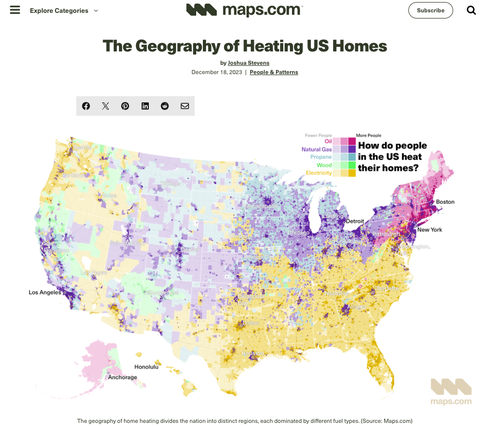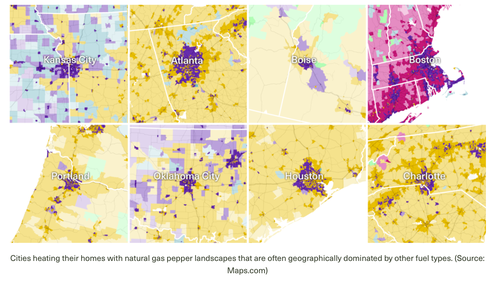Here’s How Americans Heat Their Homes…
Americans heat their homes in several ways, if that is natural gas, oil, propane, electricity, wood, and even geothermal energy, among others.
Joshua Stevens, the cartographic editor of Maps.com, published a note highlighting the geographical regions across the Lower 48 that heavily rely on furnaces, boilers, fireplaces, or electric heat pumps. He explained that the choice of heating source primarily depends on the region.
“Immediately, you can notice distinct regions that are dominated by each fuel source,” Stevens said.
He noted, “The Northeast and Alaska are reliant on oil, while much of the Southeast heats their homes with electricity,” adding, “The Midwest is a battleground between propane and natural gas, and pockets of wood-reliant regions are more common toward the west coast.”
Here’s more from the note:
A closer look also reveals how geography is a discipline of scales, and patterns change as you zoom in. At the city scale, a dichotomy emerges between rural areas and more densely populated regions. Regardless of the dominant fuel type of their surroundings, highly populated cities frequently exist as enclaves of natural gas customers.
Pipeline installation is costly and requires housing to exist to be most efficient. This makes it difficult for natural gas to be the primary fuel type in areas with few, distant houses that are already reliant on other fuels. But when housing is dense—such as in cities or suburbs—numerous homes and buildings can be served by a low number of lines. This economic factor drives much of the prevalence of natural gas use in major cities. Such a divide has caught the attention of political scientists, too: Despite many cities’ reliance on natural gas, those who dwell in urban areas—and who tend to vote differently than their rural counterparts—note a preference for alternative fuel sources.
Efforts to revamp urban fuel use are underway, but they will not come easily, cheaply, or quickly.
This map highlights the broad use of fossil fuel heating, even as far-left climate activists push to ban the NatGas heating system. The irony is that even if homes do transition to electric heat, someone has to tell the Greta Thunbergs of the world that NatGas power generators supply a majority of the power on certain grids.
Tyler Durden
Sun, 12/22/2024 – 20:25



